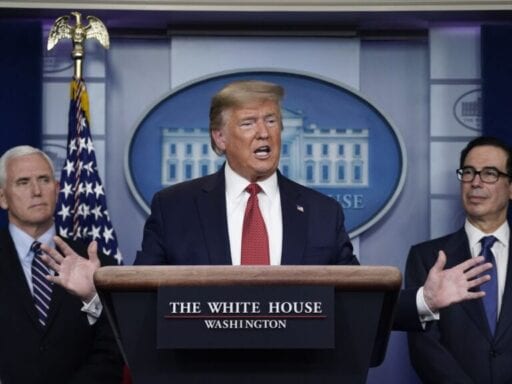Trump details plans to use increased testing and surveillance in a letter to state governors.
President Donald Trump sent a letter to state governors on Thursday saying that his administration is developing new, more relaxed social distancing guidelines for state and local officials, even as the country deals with the worsening coronavirus pandemic.
In the letter, Trump praised the governors for their role in tackling challenges brought on by the Covid-19 crisis and acknowledged the “long battle ahead” — before pivoting to his desire to return to normal. He noted:
In furtherance of this shared goal, my Administration is working to publish new guidelines for State and local policymakers to use in making decisions about maintaining, increasing, or relaxing social distancing and other mitigation measures they have put in place.
Trump’s vision for relaxing social distancing involves using expanded testing to identify those infected and robust surveillance to monitor the spread of the virus, as well as tailoring restrictions on a geographic basis. “Using these data-driven criteria, we will suggest guidelines categorizing counties as high-risk, medium-risk, and low risk,” the letter reads.
While testing capacity in the US has increased in recent days, it still lags far behind other developed countries, according to public health experts. While drive-through testing sites and laboratories continue to work overtime, increasing demand for tests means providers are still rationing them, which could ultimately put a crimp in Trump’s social distancing timeline.
Trump, however, seems eager to relax restrictions, and said in the letter that Americans are “hoping the day will soon arrive” when things can return to normal. He said on Tuesday that he hoped to “restart the economy” by Easter Sunday, which is on April 12. He said he chose the date because he “thought it was a beautiful time. A beautiful timeline,” he told reporters, suggesting that he wanted to see full churches for Easter services.
NEW: @realDonaldTrump has sent this letter to the nation’s governors. It says his administration is developing “guidelines” for lifting social distancing restrictions based on “expanded testing capability” (which doesn’t appear to exist). pic.twitter.com/6gVpVULm1R
— Andrew Feinberg (@AndrewFeinberg) March 26, 2020
Trump’s letter comes a day after more than 14,000 cases of coronavirus were reported in the US, the highest number of new cases reported in a single day in any country since the pandemic began. As of March 26, there are more than 76,000 confirmed cases in the US, resulting in upwards of 1,000 deaths, according to the Johns Hopkins University tracker.
New: United States reported 14,024 new cases yesterday. That is the most cases detected by any country in a single day since the pandemic began.
— Matt McCarthy (@DrMattMcCarthy) March 26, 2020
The virus has hit larger urban centers, like New York City, particularly hard. States have had varying experiences with coronavirus thus far, and each have taken varying steps, from statewide shelter-in-place orders to closing schools and nonessential businesses in order to mitigate the effects of the pandemic and “flatten the curve.”
But without robust testing to trace and isolate exposed individuals, many public health officials have warned that easing social distancing guidelines too early would result in more infections — and subsequently more deaths — from Covid-19, the disease caused by the novel coronavirus.
There’s danger in easing social distancing too early
While the economy has been devastated by policies aimed at stopping the spread of the coronavirus, epidemiologists say that ending social distancing too early could trigger a large spike in cases. That could not only damage the economy but also make it much more likely that an already strained medical system could collapse, as Vox’s Brian Resnick explained:
It’s understandable that some — maybe most — people want life to go back to normal already. Trump is anxious too, saying he hopes to reopen the country by Easter, April 12.
But that could be dangerously too soon. “It’s a nightmare scenario for epidemiologists and health care workers,” says Tara Smith, who studies emerging infectious diseases at Kent State University. “Imagine the mixing of populations that would happen at Easter if given the ‘all clear’ — people who may be carrying the virus without knowing it, hugging their loved ones, spending hours in close contact, and then everyone going back home afterward.”
As when a doctor asks you to consult them before ending a medication, we cannot end social distancing abruptly and without expert advice. (Think about when you’re on a course of antibiotic medication — you have to complete the whole regime of pills even when you start feeling better. Social distancing is a little like that.)
And like vaccines, the distancing isn’t just for you (although data shows that all age groups and people without preexisting risk factors can fall critically ill from the disease). It crucially protects vulnerable people from the disease. Without it, they become vulnerable again.
“If we all just went right back to how things were before, transmission would start again with the same intensity,” says Caitlin Rivers, a professor at Johns Hopkins Center for Health Security. “It’s hard to experience so many restrictions, and so many hardships, and not feel like it’s not working. We need to recognize that we are doing the right things. You just have to be a little bit patient.”
Author: Katelyn Burns
Read More



